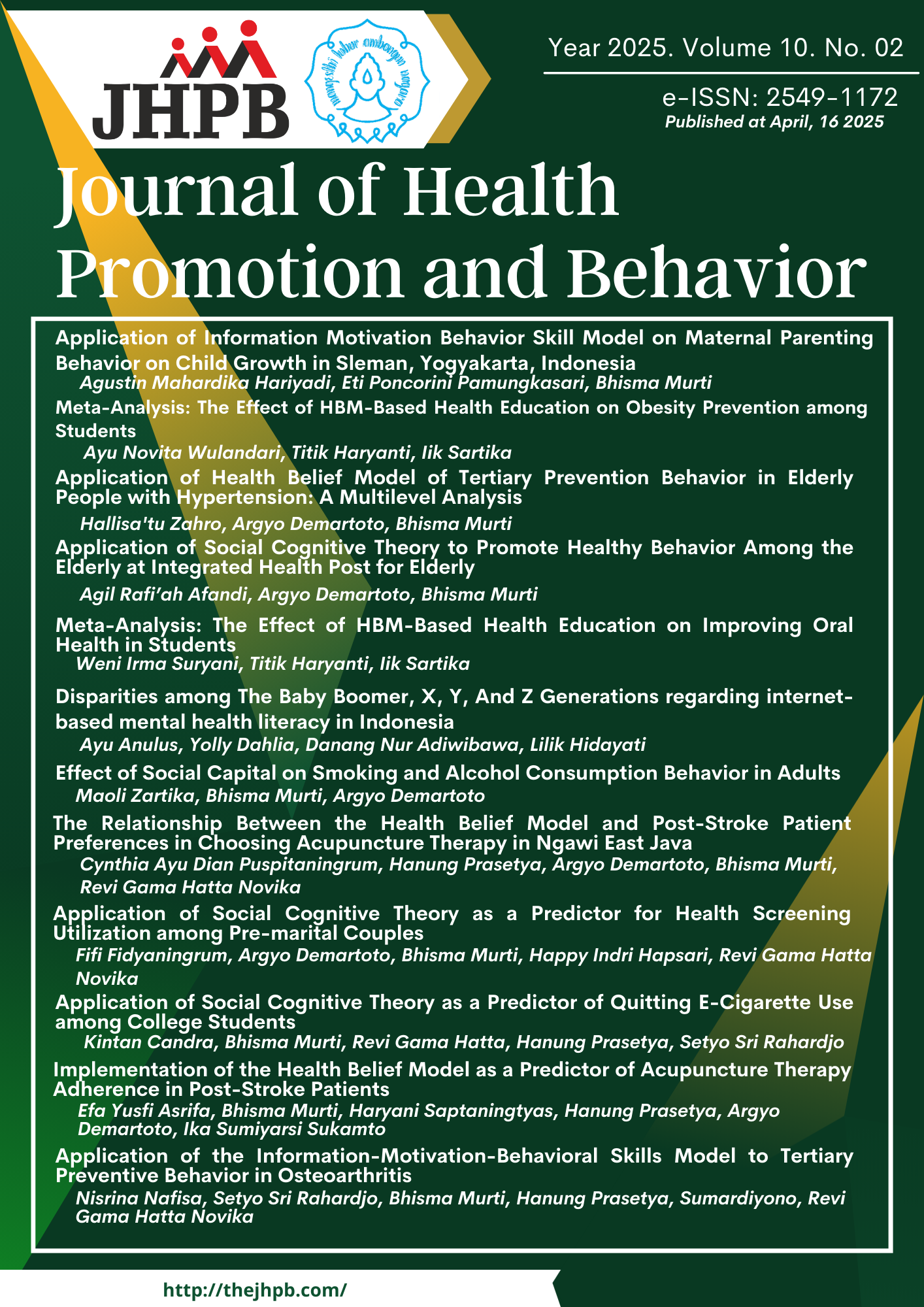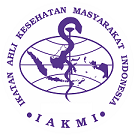Application of the Information-Motivation-Behavioral Skills Model to Tertiary Preventive Behavior in Osteoarthritis
DOI:
https://doi.org/10.26911/thejhpb.2025.10.02.12Abstract
Background: Osteoarthritis (OA) is a type of degenerative disease in which chronic joint inflammation occurs that can occur in the elderly. People with osteoarthritis will feel pain and experience functional limitations. Physiotherapy helps prevent and minimize further joint damage. The success of the rehabilitation program depends on the patient's skills in doing exercises, lifestyle changes, such as maintaining weight and avoiding activities that improve the joints. This study aims to analyze the influence of the Application of the Information Motivation Behavioral Skills Model (IMB) on the tertiary preventive behavior in osteoarthritis patients.
Subjects and Method: This was a cross sectional study conducted at a physiotherapy clinic in Surakarta, in January 2025. A sample of 210 osteoarthritis patients was selected using the fixed diseases sampling. The dependent variable was the tertiary preventive behavior. Independent variables were information, motivation, and behavioral skill. The data were collected using questionnaire and analyzed using a path analysis.
Results: Tertiary preventive behaviors in OA patients increased with behavioral skills (b= 0.45; 95% CI= 0.34 to 0.55; p<0.001) and motivation (b= 0.44; 95% CI= 0.34 to 0.53; p<0.001). Behavioral skill increased with information (b= 0.47; 95% CI= 0.37 to 0.57; p<0.001) and motivation (b= 0.35; 95% CI= 0.25 to 0.46; p<0.001). The goodness of fit indices were p= 0.285; RMSEA= 0.026 (<0.050); CFI= 1.0 (≥0.90); TLI= 0.99 (≥0.90); and SRMR= 0.01 (<0.050).
Conclusion: Tertiary preventive behaviors in OA patients increases with behavioral skill and motivation. Behavioral skill increases with information and motivation.
Keywords:
information, motivation, behavioral skill, tertiary preventive behavior, osteoarthritisReferences
Cahyaningtyas YP, Muhlisin A, Pratiwi A (2019). Gambaran Pengetahuan Keluarga Tentang Cara Penanganan Radang Sendi (Osteoarthritis) Di Komunitas UMS ETD. UMS Library. http://eprints.ums.ac.id/71886/
Chaharmahali L, Gandomi F, Yalfani A, Fazaeli A (2023). The effect of mind-fulness and motivational interviewing along with neuromus cular exercises on pain, function, and balance of women affected by knee osteoarthritis: a rater-blinded ran-domized controlled clinical trial. Disa-bil Rehabil. 46(12):2650–2661. doi: 10.1080/09638288.2023 .2 228691
Fa'izah N, Lestari U (2017). Peran promosi kesehatan terhadap tingkat motivasi pasien mendapatkan layanan fisio-terapi di puskesmas Bantimurung. Berita Kedokteran Masyarakat. 33: 293-298. doi: 10.22146/bkm.24 242.
Fassier JB, Samin P, Rouat S, Peron J, Kok G, Letrillart L, Lemort-Bouche M (2019). Interventions developed with the intervention mapping protocol in work disability prevention: A sys-tematic review of the literature. J Occup Rehabil. 29(1):11-24. doi: 10.10-07/s10926-018-9776-8.
Fatati M, Rahardjo SS, Prasetya H (2020). Lateral Wedge Insole Uptake in Redu cing Pain in Patients with Knee Osteo arthritis: A Meta-Analysis Study. ICPH Proceeding. 5(01):413. doi: 10.269 11/the7thicph.05.45.
Fisher JD, Fisher WA (2023). An Infor-mation-Motivation-Behavioral Skills (IMB) Model of Pandemic Risk and Prevention. Advances in psychology. 1(1): 1-26. doi: 10.56296/aip00004.
Hudaya P (2015). Reumatologi. Revisi Keempat. Surakarta.
Hunter dan Bierma Z (2019). osteoartritis. 393:1745-1759. doi : 10.1016/S0140- 6736(19)30417-9.
Khairiyyah AU, Murti B, Tamtomo DG (2024). Path analysis: Multilevel ana-lysis of information motivation beha-vioral skill models and its effect on tertiary preventive behavior in elderly with type-II diabetes mellitus. J Health Promot Behav. 09(03):226-23. doi: 10.26911/thejhp b.2024.09.03.04.
Kraus V, Blanco FJ, Englund M (2015). The role of inflammation in osteoartritis. J Rheumatol. 42:(1), 102-108.
Pratama AD (2019). Intervensi Fisioterapi pada Kasus Osteoartritis Genu di RSPAD Gatot Soebroto. J Sosial Hum Terapan. 1(2):21-34.
Sahrin R, Ng CJY, Lim CJ (2023). Exploring the role of the built environment and psychosocial mediators on knee func-tion in knee osteoarthritis patients in Singapore: a cross-sectional study. BMJ Open. 14. doi: 10.1136/bmjopen-2023-082625.
Skou ST, Odgaard A, Rasmussen JO, Roos EM (2012). Group education and exercise is feasible in knee and hip osteoarthritis. Danish medic. 59(12).
Simick BN, Duong V, Eyles J, Cui H, Gould D, Barton C, Belton J, et al. (2024). How does osteoarthritis education influence knowledge, beliefs, and behavior in people with knee and hip osteoarthritis? A systematic review. Arthritis care res. 76(11): 1511– 1531. doi: 10.1002/acr.25391.
Simpson EH, Balsam PD (2016). The Beha-vioral Neuroscience of Motiva tion: An Overview of Concepts, Measures, and Translational Applica tions. Current Topics Behav Neurosci ences. 27:1–12. doi: 10.1007/785 4.2015.402.
Suriani S, Lesmana SI (2013). Theraband exercises are better to lower pain than quadricep bench exercises in genu osteoarthritis (Latihan theraband le-bih baik menurunkan nyeri daripada latihan quadricep bench pada osteo-artritis genu). Jurnal Fisioterapi. 13-(1):46-54.
Rahman F, Anugerah RWD (2021). Hubungan Kepatuhan Aktivitas Fisik Dengan Kapasitas Aerobik Pada Pasien Osteoartritis Lutut Di RSUD Dr. Moewardi. Physio Evidn. 3(2):130-135. doi: 10.239 17/fisiomu.v3i2.18062.
Wang Y, Guo X, Chen B, Chen H, Chen Y, Ma L, Liu H (2023). The Relationship Between Psychosocial Behavior and the Quality of Life of Male Gout Patients in Southwest China: A Cross-Sectional Study Based on an Information-Motivation-Behavioral Skills Model. Patient Prefer Adhe-rence. 17:3503-3514. doi: 10.214-7/PPA.S434875.
Willet M, Duda J, Fenton S, Gautrey C, Greig C, Rushton A (2019). Effec-tiveness of behavior change techniques in physiotherapy internventions to promote physical activity adherence in lower limb osteoarthtitis patients; A systematic review. PloS One. 14(7). doi: 10.1371/journal.pone.0219482.





